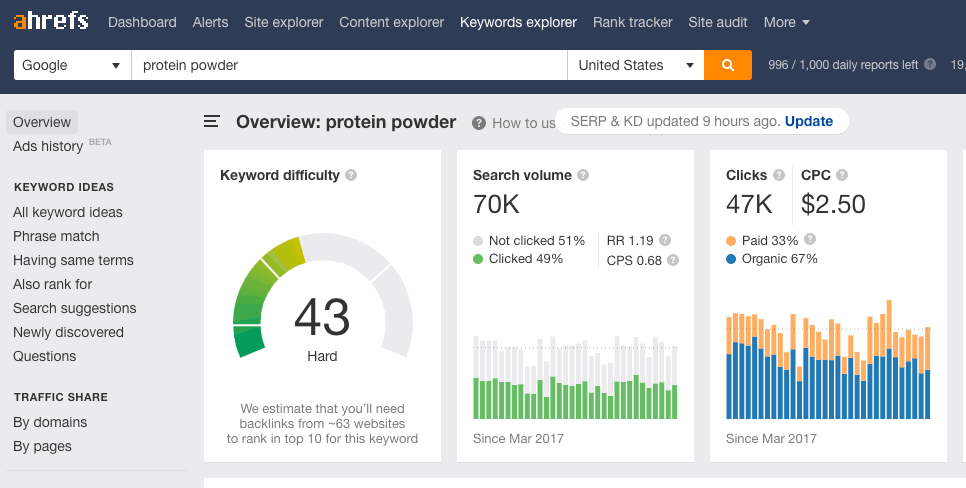People often ask us—“what makes Ahrefs better than the competition?”
It’s a fair question, but a tough one to answer because there are just so many things to compare.
So instead of filling out one of those classic “us VS. them” comparison tables, we decided to go a different route and showcase some of Ahrefs’ unique features and functionalities.
Disclaimer
These features were selected by comparing Ahrefs to other similarly priced all-in-one SEO tools. It’s quite possible that some of the lesser-known, more specialised SEO tools have one or more of these features.
1. Do keyword research for 10 search engines
Most keyword tools only show data and metrics for Google. That makes sense given their near-monopoly of the search engine market, but it’s important to remember that you can also get traffic from other search engines.
Here are the supported search engines in Ahrefs’ Keywords Explorer:
- Google;
- YouTube;
- Amazon;
- Bing;
- Yahoo;
- Yandex (Russia);
- Baidu (China);
- Daum & Naver (South Korea);
- Seznam (Czech Republic)
Just toggle between each of them to see respective monthly search volumes for any keyword.
Whether or not you care about search engines in Russia, China, South Korea, or the Czech Republic, or sell products on Amazon, you should consider your company presence on YouTube. Our own YouTube channel is pulling nearly 300k views per month, with 91% of these views coming from “keyword targeted” videos.
Sidenote.
There are quite a few other tools that let you research keywords for YouTube and Amazon, but most of them source their data from “autosuggest” and show questionable search volumes. Here at Ahrefs, we use anonymous clickstream data to build our keyword databases, which makes our tools arguably the most reliable in the industry.
2. Go beyond search volume with “clicks” data
Keywords Explorer is the only keyword research tool on the market to go beyond search volumes and show the estimated number of clicks on search results. This is useful for assessing whether or not a keyword is actually worth targeting.
For example, take the query, “Donald Trump age”:

There are an estimated 64,000 monthly searches for this term, but because Google shows an instant answer, there are only 9,000 clicks.
Sidenote.
We calculate these numbers using clickstream data from our partners.
For some keywords, we see the opposite.
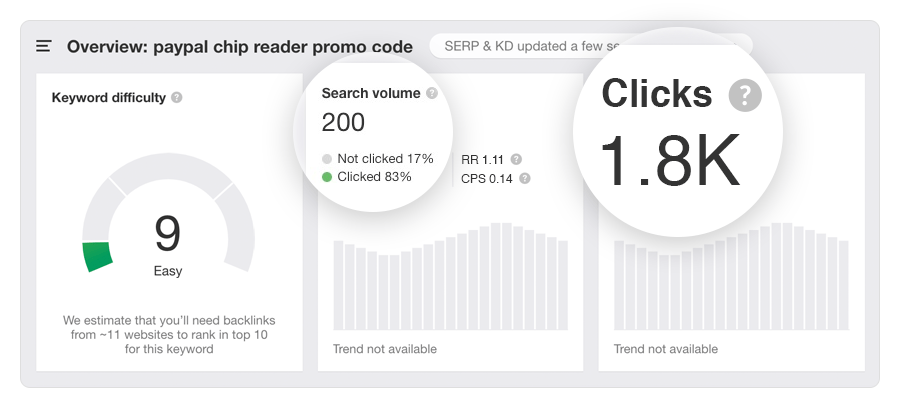
Here, there’s are 1,800 monthly clicks despite a search volume of just 200. This means that the average search sees almost ten clicks. In this case, that probably happens because searchers are looking for a working promo code, so keep clicking results until they find one.
Always target keywords that get clicks over those that don’t.
See which keywords get the most clicks in your country…
If you’re curious which queries generate the most clicks on a particular search engine, run an empty search and sort the results by the “Clicks” column.
Here we can see that “asmr” is the term that generates the most clicks on YouTube in the US:
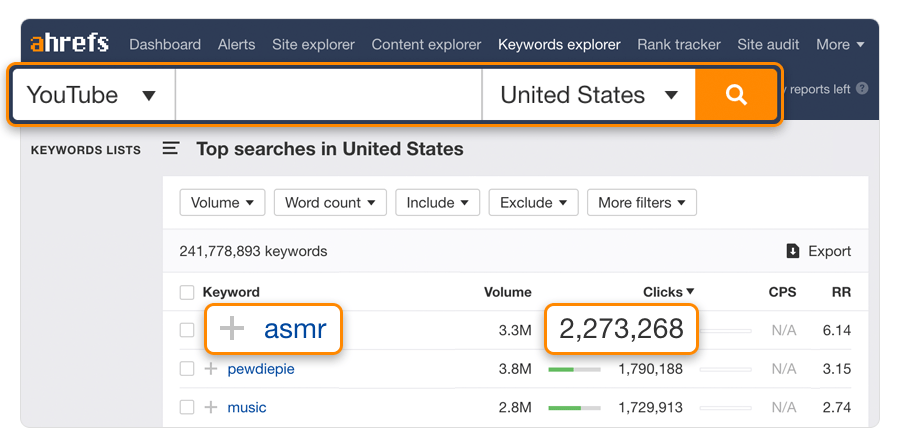
3. Get total search traffic estimations for the top 10 ranking pages
Most SEO professionals look at the search volume of their target keyword to predict a page’s organic traffic potential. That’s a problem because pages don’t tend to rank for just one keyword, and often rank for thousands of long-tail keyword variations.
So how do you estimate “total search traffic potential” for your target keyword?
Easy. Use the “SERP overview” report in Ahrefs’ Keywords Explorer to check the estimated monthly organic search traffic to the current top-ranking pages:
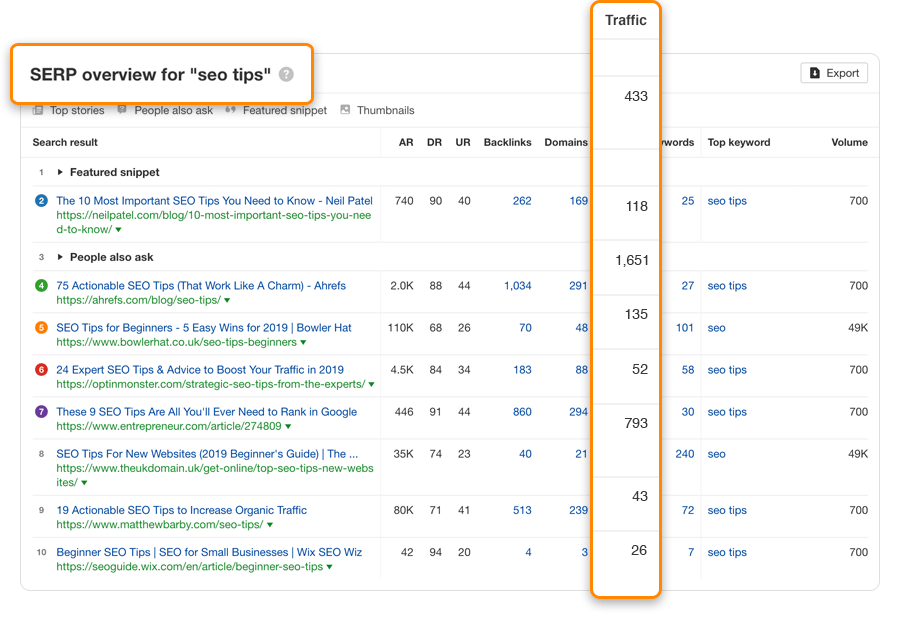
“SERP Overview” for “SEO tips” in Ahrefs’ Keywords Explorer.
Note that this report shows each page’s total estimated organic traffic from the selected country. For global traffic estimates, hit the caret next to the URL:
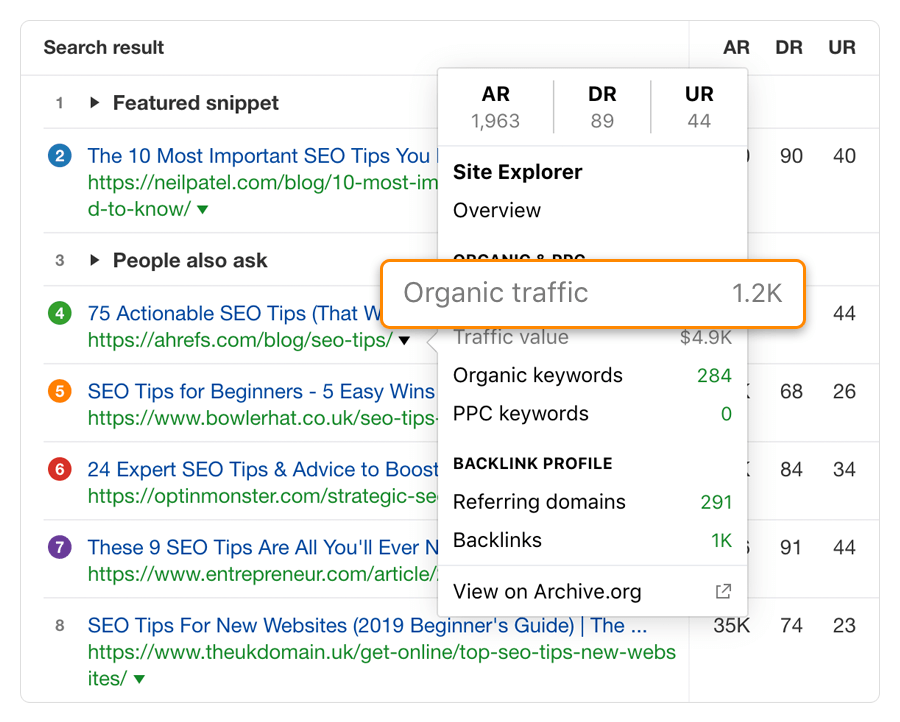
Sidenote.
The “SERP overview” report is integrated across most of our tools. Wherever you see a keyword in Ahrefs, there should also be a “SERP” button that lets you analyze the top-ranking pages.
Why you shouldn’t rely on search volume estimates…
To help drill home how misleading search volumes can be, compare the monthly searches for these two keywords with the estimated traffic to the top-ranking pages:

This screenshot explains why we choose keywords by looking at the average traffic to the current top-ranking pages—not the search volume.
4. See backlink growth (or decline) over time, with daily granularity
Thanks to our continued investment in web crawling technology and infrastructure, Ahrefs is the only tool to update backlink graphs daily.
Here’s what it looks like for the Ahrefs blog:
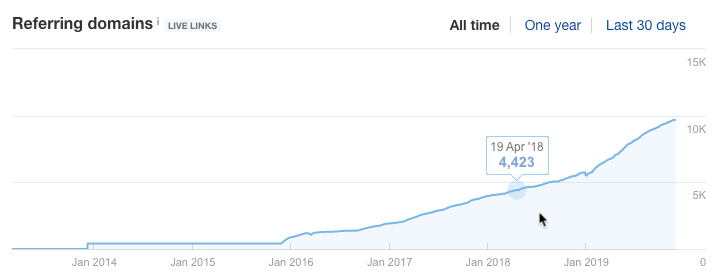
“Referring domains” graph for the Ahrefs Blog in Site Explorer.
One glance tells us that our blog’s link profile grew by around 1,500 referring domains in 2018. And in 2019, it’s on track to increase by more than 5,000.
This level of granularity allows you to accurately compare your own link acquisition pace with that of your competitors to see if you’re on a track to catch up.
Using these graphs to spot negative SEO attacks…
Back in October 2018, our free backlink checker fell victim to a negative SEO attack when someone sent tens of thousands of low-quality backlinks our way in a short period of time.
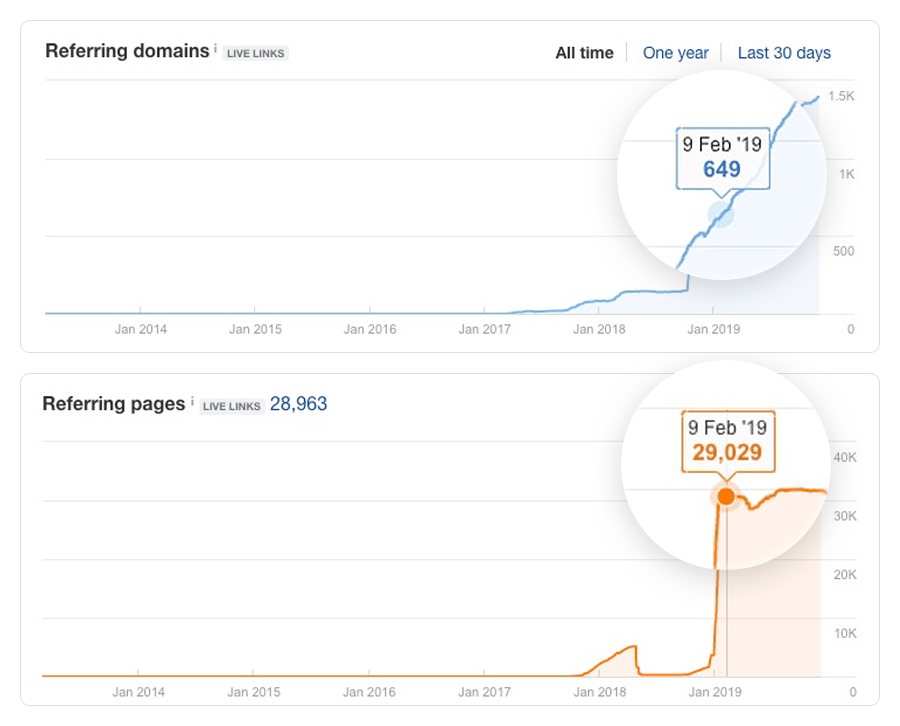
Fortunately, this didn’t negatively affect our rankings and traffic, but not everyone is so lucky. That’s why it’s worth keeping an eye out for these kinds of attacks and disavowing links where needed.
5. See which subfolders attract the most organic traffic for your competitors
The “Top Subfolders” report in Site Explorer helps you better understand your competitors’ website structure, along with which sections of their site generate the most search traffic from a particular country.
Here are the top subfolders by estimated US organic traffic on ahrefs.com:

Here are a few key things you can learn about our SEO strategy by skimming this report:
- Our blog is responsible for 63% of all US search traffic to our site;
- Four blog posts are responsible for 24% of US traffic;
- Our free backlink checker is our most popular page outside of the blog (besides the homepage)
View top subfolders for global traffic…
If your site gets a lot of international traffic, another unique feature in Ahrefs is the ability to go beyond one country and see the top subfolders for global traffic.
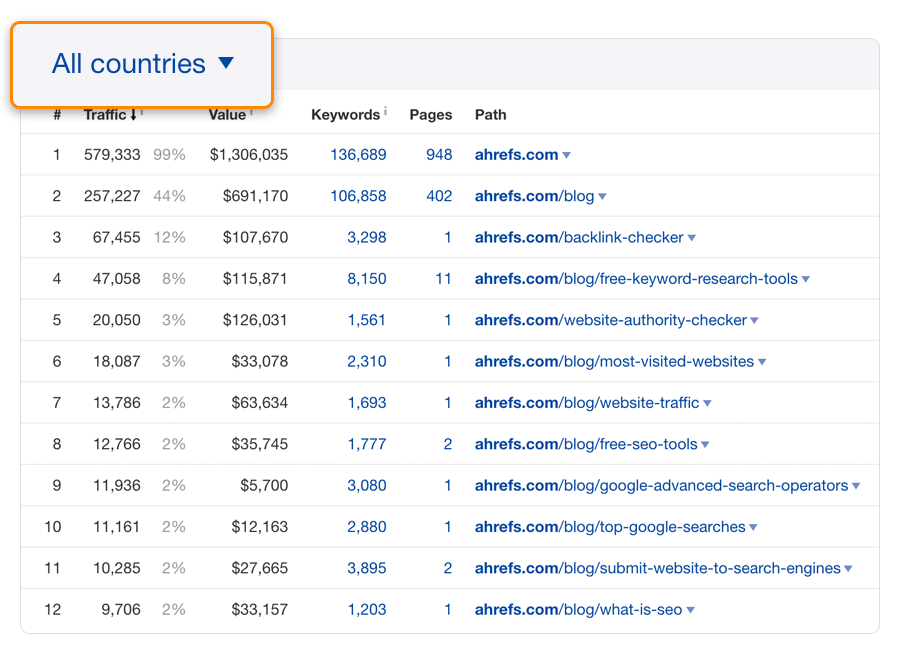
From this, we see that:
This setting is available in the following reports in Site Explorer:
- Top pages;
- Top subfolders;
- Top subdomains.
6. See click distributions for individual keywords
Conventional wisdom tells us that around 30% of clicks go to the top-ranking result, 15% to the page in position #2, and so on. But these numbers are misleading because they’re averages. In reality, every keyword has a unique CTR curve of its own.
Because we at Ahrefs process large amounts of clickstream data, we’re able to calculate and show this for most keywords.
Just type your query into Keywords Explorer, then go to the “Traffic share by pages” report.
Let’s look at the query, “Google Analytics”:

Here, 99% of all clicks go to the top-ranking page because it’s a navigational search, meaning that most people are looking for a specific page.
Use this data to make better SEO decisions…
Take a keyword like “insurance,” which has a monthly search volume of 196,000 in the US. The conventional CTR model suggests that the top-ranking page should get around 60,000 (~30%) clicks from this keyword.
But this isn’t the case:
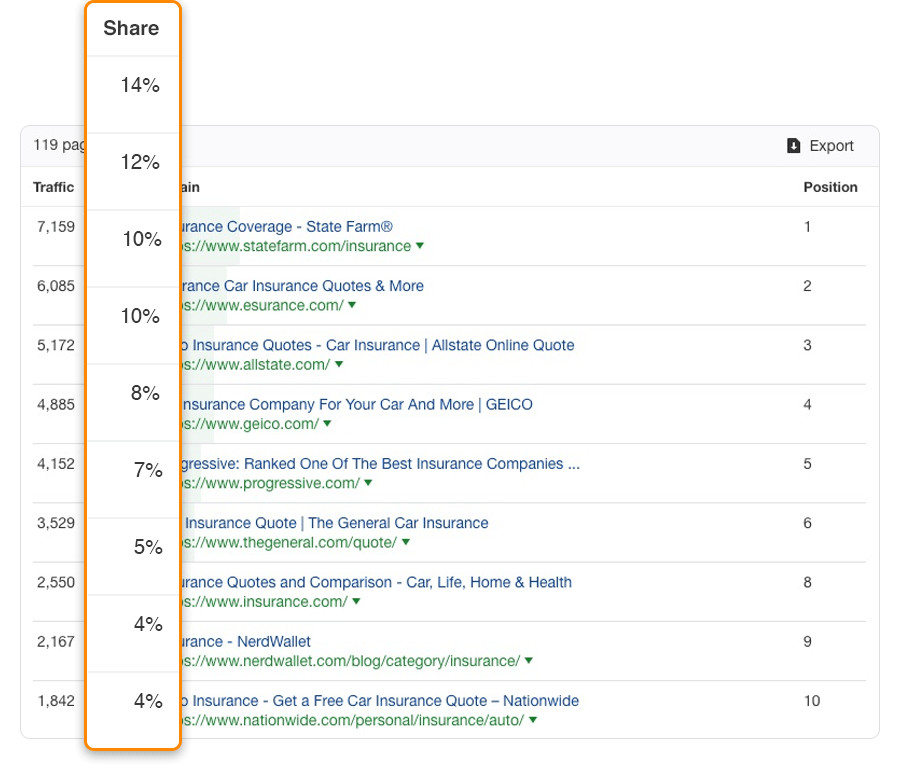
Here, clicks are quite evenly distributed across the top-ranking results, meaning that there’s traffic to be had even at position 10.
Note that we also account for clicks lost to paid ads, which is why the total traffic numbers are lower than you might expect.

7. Analyze SERP history
Before pursuing a particular keyword, make sure to investigate the battles that took place amongst the top search results in recent years.
For example, here’s the SERP history for the query, “link building”:
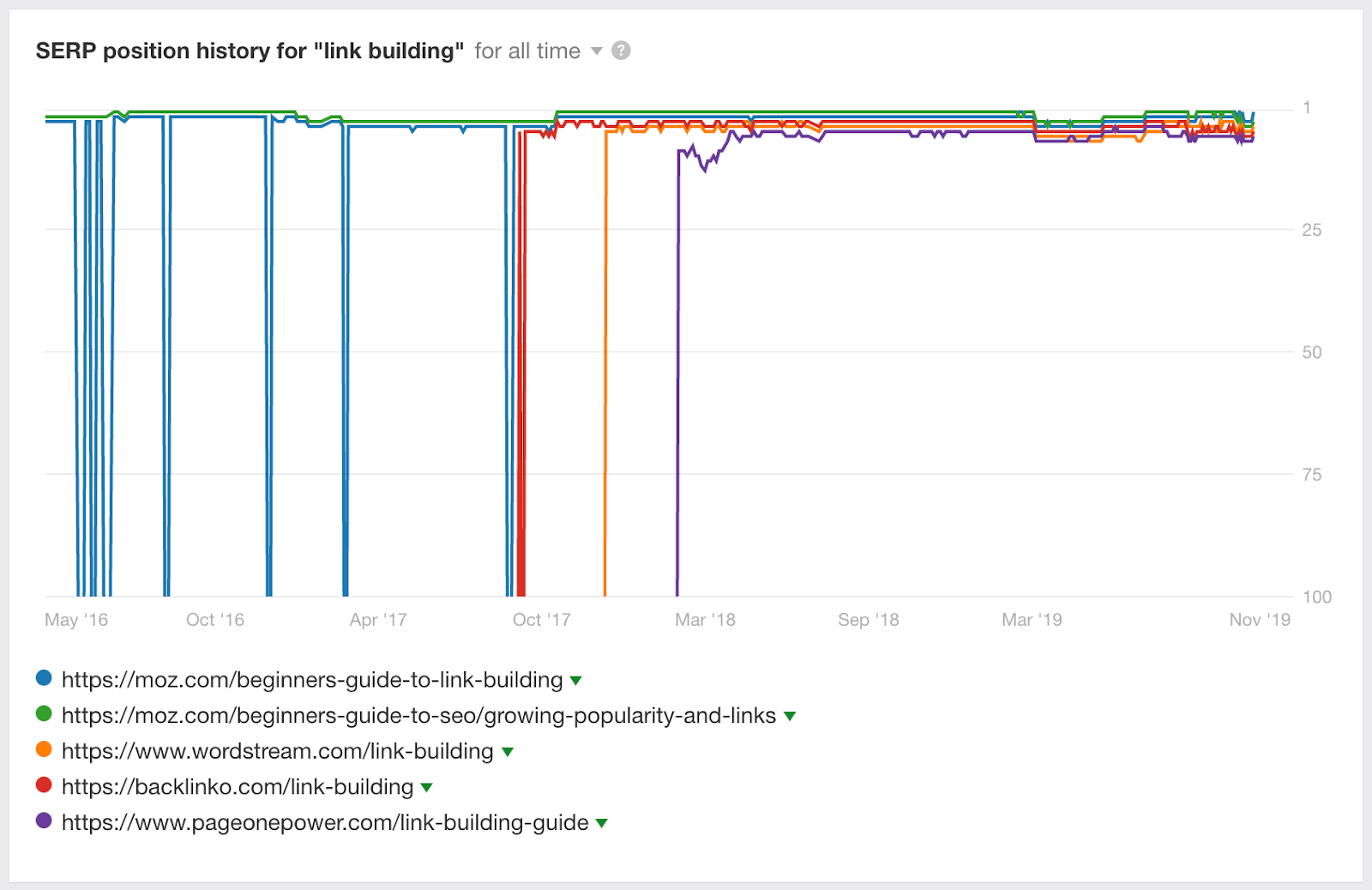
The pages currently ranking in the top 5 have been there for the past ~18 months, which suggests that it would be quite a feat to beat any of them.
It’s a different story for the query, “backlink checker.”

Here, a clear battle is taking place with many newcomers penetrating the top five in the past 12 months. This suggests that they’ve made a deliberate attempt to rank for this query, so it may be worth analyzing their backlink profile and overall SEO strategy for clues as to how they did it.
Sidenote.
Use The Wayback Machine to monitor for changes on the pages that suddenly darted to the top. For example, the reason our free backlink checker climbed to the top spot so fast is that we changed it from a “feature page” to a free tool. (Check out our vlog episode about this.)
8. Uncover content gaps between you and your competitors
You’ve probably already heard of a “content gap” analysis. It’s where you look for keywords that your competitors rank for, but you don’t.
Lots of tools have this functionality. It’s not unique to Ahrefs.
What is unique to Ahrefs, however, is the ability to do this at the URL or subfolder level.
How is this useful? Imagine that you’re working on a blog content strategy. You wouldn’t want to compare your entire website to competing sites, but rather just your respective blogs (which reside in subfolders).
To do this in Ahrefs’ Content Gap tool, use the “prefix” mode.

Content Gap tool showing popular topics that the Wordstream Blog ranks for, but we don’t.
Dig into the keywords that the competing blog ranks for, and add any that make sense to your content calendar.
Run a content gap analysis at the page-level to improve content relevancy…
If Google doesn’t think your page covers the topic in enough depth, your rankings may suffer.
One way to uncover subtopics that you forgot to include is to run a content gap analysis at the page level. Take a page on your site that doesn’t rank well for its target keyword, then compare it to the current top-ranking pages using the “URL” mode in our Content Gap tool.
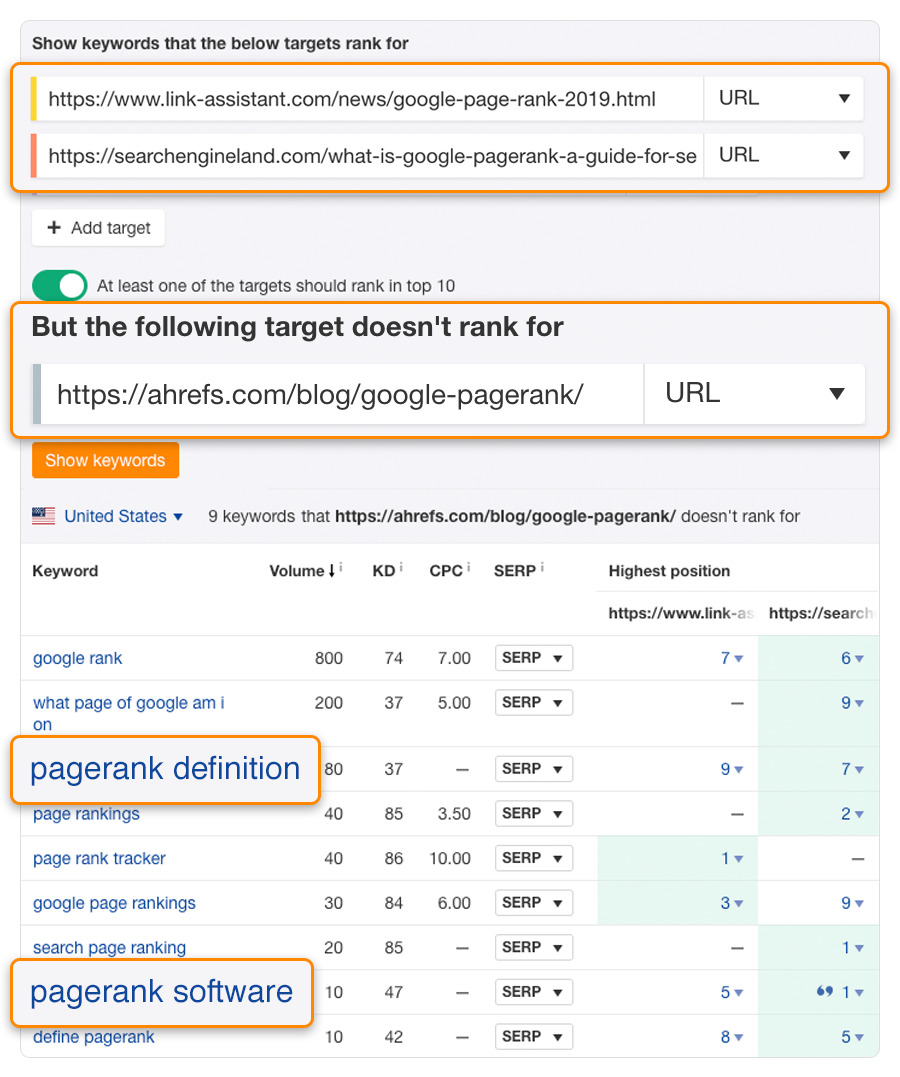
Running a URL-level content gap analysis for our our PageRank guide, which currently ranks #6 for “pagerank”.
Here, it’s clear that we should update our guide with a clear “PageRank definition,” and possibly add some “PageRank software” recommendations.
For more ideas on how to use the Content Gap report, check out this YouTube video.
9. See the ranking history of any website for any keyword (and compare with competitors)
Knowing how your pages used to rank for particular keywords can be extremely insightful—and you can do that in Site Explorer.
Site Explorer > enter website > Organic keywords > choose a keyword > click the “history” icon
Here are our rankings for “keyword research” over the past four years:

By disabling a few pages on that list, we can see that our guide to keyword research used to rank in the top 3 quite consistently.
But near the end of 2018, Google decided that our other article was a better fit for this keyword (which we don’t necessarily agree with):

From here, we can add a competitor to see if their performance has been any better.
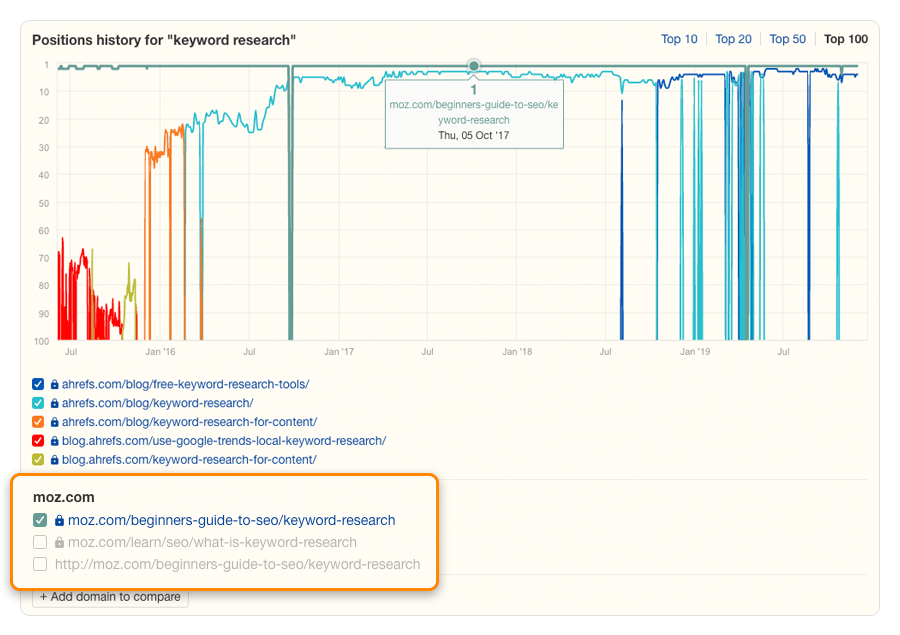
It looks like Moz’s keyword research guide ranked #1 for years, while ours never even hit #2.
Use this feature to discover ‘keyword cannibalization’ issues
Look at Moz’s ranking history for the keyword “local SEO:”
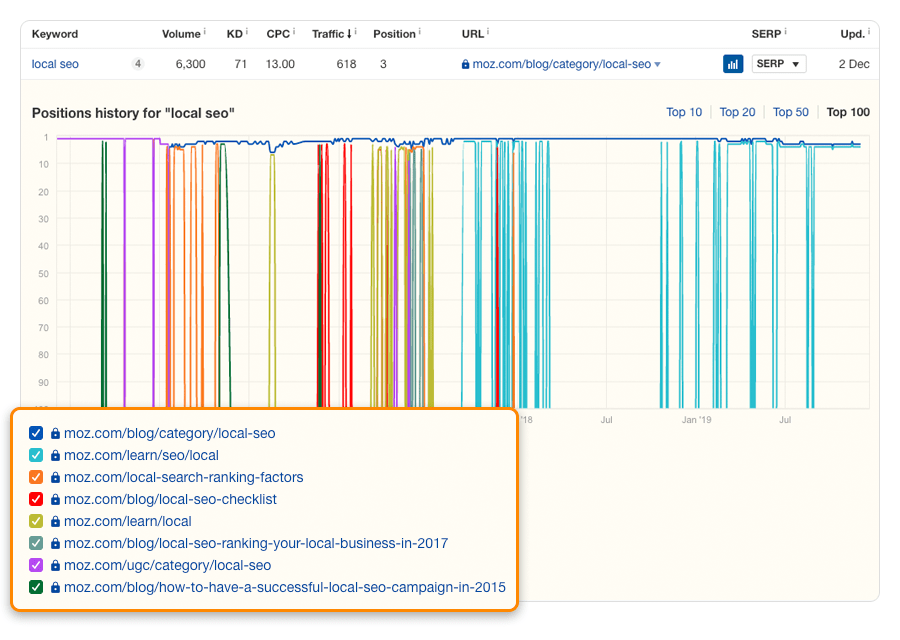
Eight unique pages on their site have ranked for this query over the years, but none rank in the top 3 today. This is potentially a ‘keyword cannibalization’ issue, so it might be worth them consolidating some of that content to try to reclaim the top spot.
Recommended reading: How to Find and Fix Keyword Cannibalization Issues (in Seconds)
10. Monitor your website’s outbound links
It’s important to keep an eye on your external links, especially when you have a team working on your site.
For instance, we recently hired a few freelancers to translate our blog posts into other languages. While browsing the “Linked domains” report shortly after, I noticed two small issues.
First, while we do credit translators with a link, we don’t allow commercial anchor text as there’s a chance Google might see it as manipulative. But one had slipped through the net.

Second, two of the URLs we shared for demonstration purposes in an original article got turned to live links in the translated version, which was never our intention.

In our case, neither of these issues was a big one, but the “Linked domains” report might be a lifesaver should someone hack your site and inject shady links to try to hurt your rankings.
Monitor for new broken outgoing links…
Link rot is another common issue when it comes to outgoing links. This is where sites and pages you link to break over time. To keep an eye on these, head to the “Broken links” report under the “Outgoing links” section in Site Explorer.
Here, you can see that although we treat our blog with unprecedented care, there are still a few broken outbound links.
While broken outbound links are unlikely to be a critical ranking signal for Google, it’s worth fixing these if you respect your readers and don’t want them to waste time clicking on dead links.
11. Find link prospects with Content Explorer
Content Explorer is a searchable database of 1.1 billion web pages, complete with these proprietary metrics:
- Domain Rating (of the parent website);
- Number of referring domains;
- Organic search traffic;
- Word count;
- Publish date;
- Updated date;
- Live/broken;
- Author
No close competitors for the tool exist, and there are more use cases than I have time to cover in this article. So let me share two of my favorite ways to use it for link prospecting.
1. Find thousands of relevant blogs to pitch
There’s evidence to suggest that the most powerful backlinks come from relevant, high-authority websites that have never linked to you before.
To find these in Content Explorer, search for pages with your target keyword in the title. Then, filter for sites with a “comfortable” Domain Rating, and toggle to see only “One page per domain.”
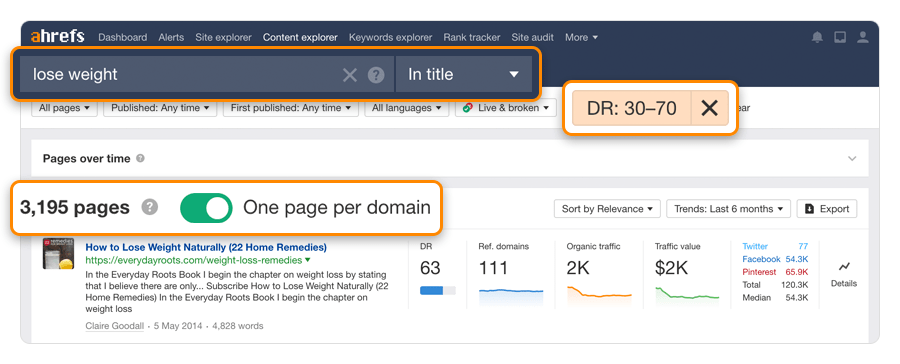
Next, use the “highlight unlinked domains” function to highlight results from sites that haven’t linked to you before.

This is how you find thousands of relevant, authoritative blogs to pitch in less than 60 seconds. Ones that talk about similar things to yours, but have yet to link to your website.
2. Finding broken link building opportunities
Search for pages with a relevant word or phrase in their title, filter for broken pages only, then filter for results with at least 50–100 referring domains.
Here’s a broken double broccoli quinoa recipe with 203 referring domains:
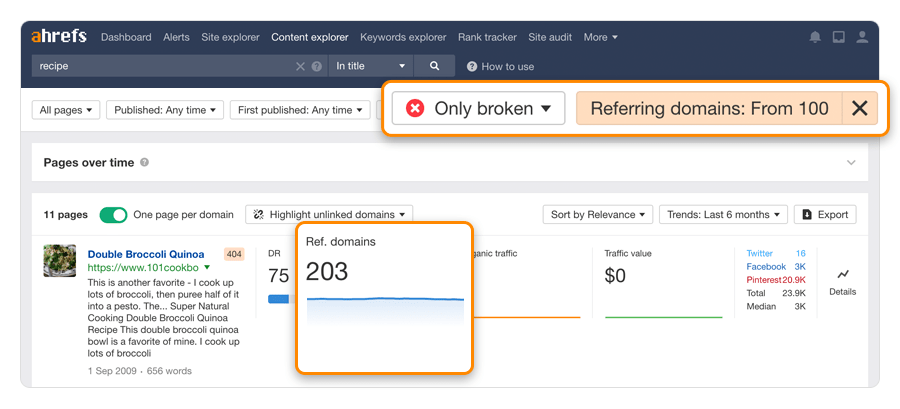
If we hit the caret and follow the link to the Wayback Machine, we can confirm that this page did indeed used to be home to a broccoli quinoa recipe.

If we had a site in this niche, we could create a similar piece of content on our site, then ask everyone linking to the dead page to link to us instead.
Find low-competition topics with Content Explorer…
Search for relevant words and phrases in the content of pages, then filter for those with zero referring domains and more than 500 monthly search visits.
Here’s a banana-oatmeal recipe that gets 1k monthly organic visits while having no links:

This is a great way to find topics that you can potentially rank for without building any backlinks.
12. Get an email alert with keyword ranking improvements
Every week, Ahrefs sends me an email report with all the keywords our website has started ranking for in positions 1–3.

Think of this as rank tracking on steroids. With rank tracking tools, you have to specify keywords to monitor before you see updates. Because Ahrefs already tracks rankings for 500 million keywords, we’re able to tell you when you start ranking for any of them.
To set up a new keyword alert, go to:
Alerts > New keywords > New alert > enter domain, subsection, or URL > choose settings and frequency

This is a great way to track your website’s ranking progress and monitor competing websites on autopilot.
Win extra respect from your clients with this report…
Try sending this report to your client. They probably expect you to rank them for the few dozen of their most important keywords, but they’ll surely be happy to see all the other keywords they’ve begun to rank for since working with you.
13. Instantly analyze the internal backlinks of any website
Struggling to push an important page higher in the search results? I’m sure you already know how many external backlinks it has, but what about internal backlinks?
Head to “Best by links” report in the Site Explorer, and switch to the “Internal” tab. This shows the number of internal links to each page on the website.
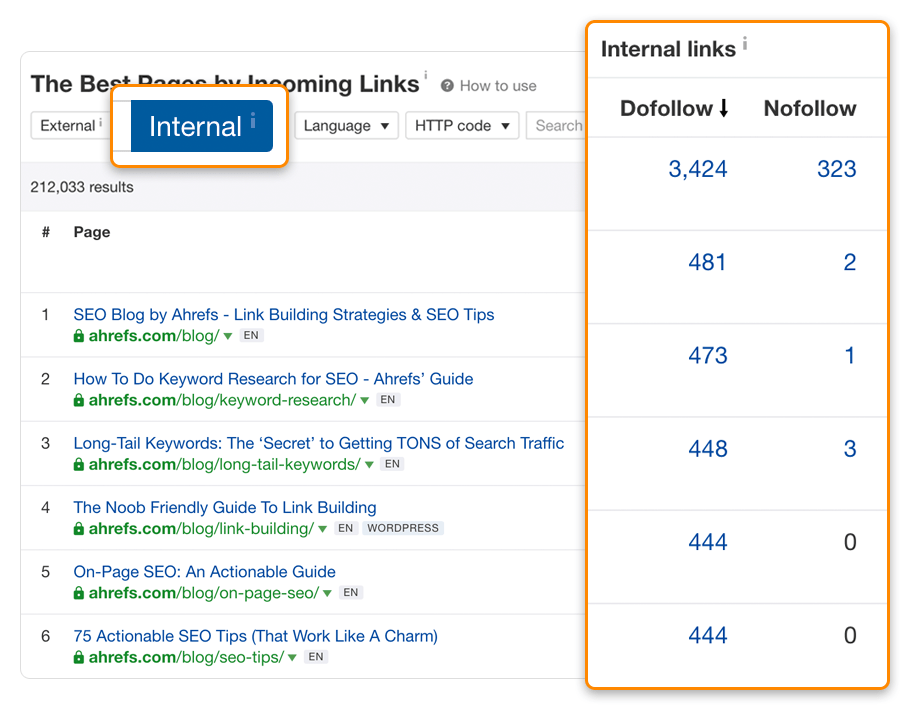
Click on the blue numbers to see the actual linking URLs and the linking anchor texts. This is a handy way to run a quick internal links audit and decide if anything needs adjusting.
While internal backlinks carry disproportionately less weight than external ones, don’t underestimate how much value you can pass to a page via internal linking. A few strategic internal links might be enough to boost your page by a few positions.
Sidenote.
Most website crawlers give you information on the internal links. The benefit of Ahrefs is that you don’t have run a crawl and wait for it to finish. The data is already there. This is handy if you need to create a quick proposal for a prospective client and don’t have time to crawl their site.
That’s obviously not everything…
Ahrefs has many more unique features and data points.
For starters, I haven’t even mentioned our Rank Tracker and Site Audit tools, which have quite a few features that other similar solutions don’t have.
Perhaps I should write a follow-up article and showcase more of the unique things that only Ahrefs can do? What do you think?
